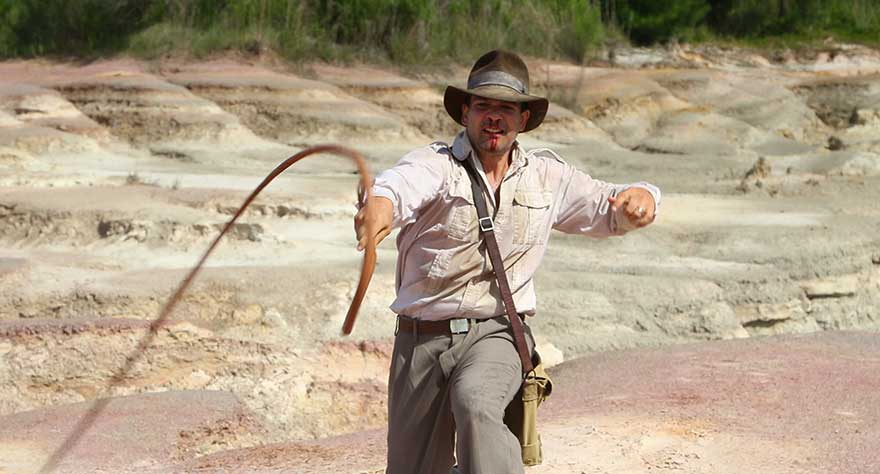Raiders!: The Story of the Greatest Fan Film Ever Made
 From my pre-teens through high school in the 1980s, I spent summers watching movies. During those countless hours of screen time, the most ambitious thing I ever did was go through a used copy of Halliwell’s Film Guide and check every movie I had ever seen, complete with notes in the margins.
From my pre-teens through high school in the 1980s, I spent summers watching movies. During those countless hours of screen time, the most ambitious thing I ever did was go through a used copy of Halliwell’s Film Guide and check every movie I had ever seen, complete with notes in the margins.
Thrilling, I know.
This major milestone in my young, film-centric life is nothing compared to the cinematic endeavor a trio of Mississippi teens undertook in the 1980s: they filmed a shot-for-shot remake of Steven Spielberg’s Raiders of the Lost Ark, starring themselves and their friends. The only scene they didn’t shoot was the airplane scene. Fast-forward over three decades when the trio decides to reunite and complete their feature-length homage. Raiders!: The Story of the Greatest Fan Film Ever Made, making its international premiere at Hot Docs on Sunday, April 26, documents that last leg of the boys’ amazing cinematic journey.
And what a sensational documentary Raiders! is, with strength of both story and storytelling. So many times, the appeal of a documentary rests squarely on the shoulders of its subject, not the documentarians. Raiders! isn’t like that. Sure, the story alone would be worth watching even if the telling of it were weak, but co-writers/co-directors Jeremy Coon and Tim Skousen don’t rest on that. These filmmakers know what they are doing when it comes to taking a good story and making it a great documentary. In fact, it’s more than one great documentary; it’s two.
One documentary is about the audacity of youth. With great energy and determination, but most importantly without knowing any better, three childhood friends—Eric Zala, Chris Strompolos, and Jayson Lamb—decided one summer to reshoot one of the greatest action films ever made. The shoot lasted seven summers and tested the mettle of the boys’ creativity, their parents’ patience, and the strength of their friendship.
The other documentary is about the power of ego. This is not a negative statement. Despite the fame the trio received for their effort; despite the cult status their film received with help from the likes of director Eli Roth, journalist Chris Gore, and Alamo Drafthouse owner Tim League; and despite what they had accomplished … the film wasn’t done. Everyone else might say, “They remade Raiders of the Lost Ark,†but they say, “We remade Raiders of the Lost Ark except … .†Now, at an age when the success of adulthood can help realize the dreams of childhood, that caveat can possibly (and finally) be removed.
Bridging these stories is the small but important piece about their post-audacity, pre-ego lives. The paths the boys took, which were paths that began in the later years of their original filming, are divergent indeed, and that sliver of story plays like a basic cable mash-up of “Behind the Scenes†and “Where Are They Now†specials (minus any unnecessary salaciousness).
Binding these stories is the film they made, the film they hope to finish: Raiders of the Lost Ark: The Adaptation. How this film was started, how it almost stopped before it started, how it finally stopped only an inch shy of the goal line, and how it restarted and carried on, is captured in a parallel presentation of documentary-style interviews with the trio, their family and friends, those aforementioned celebrities, and more. And don’t think the chances they took as boys were more dangerous than the risks they take as men. They may have almost burned down a house as youngsters, but as adults they have “real life†responsibilities that raise the stakes to levels their teenage selves would not have been able to comprehend.
How this is all combined is the film’s secret weapon, and without the precision cuts made by editor Barry Poltermann, this thing could be a muddled mess. Instead it’s lean and rhythmic, and every scene it cuts to from the past leaves you wanting another scene from the present, and vice versa.
Raiders!: The Story of the Greatest Fan Film Ever Made is a triumphant tale of fandom, filmmaking, family, and friendship. Less a making-of-within-a-making-of and more a pair of dueling, time-shifting stories, the documentary finds a great balance between the nostalgia of yesterday and the dreams of today.






